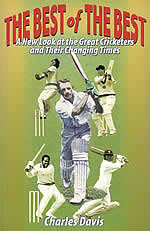The Best of The Best
Stuart Wark |Published: 2000
Pages: 237
Author: Davis, Charles
Publisher: ABC Books
Rating: 3.5 stars

As my university maths lecturers would attest, I am not overly gifted numerically. However, I do enjoy the statistical side of cricket, and love pouring over player performances. Statistics never divulge the full truth – but they can be used to provide some useful context for cricketers from other eras. Charles Davis, a cricket historian and statistician from Melbourne, produced one of the most fascinating books I have ever read – “Best of the Best”.
Davis has used statistics and statistical analysis in a bold attempt to standardise the performances of players across all eras of test cricket. He has come up with a methodology for both batsmen and bowlers that tries to take into account the historical variables such as uncovered pitches, the quality of opposition, and the length of career. This statistical re-balancing allowed Davis to arrive at an adjusted batting average and bowling rating. Batsmen who feasted on weak attacks in good conditions will see their average reduced, whilst batsmen who performed well against strong opposition bowlers would see a rise in their figure. This recalculation is done for all players across all test cricket, and by doing so, Davis has come up with a system that allows direct comparison between eras.
This methodology naturally has some inherent assumptions that may or may not be completely valid. However, it is undoubtedly the most comprehensive attempt to re-rank every test player in history, and the results are fascinating reading. The greatest bowler of all-time under Davis’ system is the great Sydney Barnes. Whilst his rating was affected by the fact he played in an era of lower scoring (1901-1913), Barnes still came out on top. He finished in front of another legend in Bill O’Reilly. Interestingly, Don Bradman personally rated these two individuals as the greatest bowlers of all-time. Other bowlers in the top ten include Richard Hadlee, Dennis Lillee and Malcolm Marshall. George Lohmann, who played in the 1880s and 90s, has probably the most amazing test bowling statistics of all-time. However, because of the limited opposition and bowler friendly pitches, he drops to no. 7 in Davis’ rankings.
The greatest batsman of all-time is, unsurprisingly, one Donald Bradman. However, it is interesting to see what happens to Bradman’s average after Davis’ recalculates it. Bradman’s original test average is 99.94, but after Davis takes into account the limited number of teams he played, and the batsmen friendly pitches, his average drops by nearly 15 runs back to 84.5. This figure is still in excess of 25 runs in front of his nearest competitor, Graeme Pollock (whose own adjusted average is 58.9, down from his test figure of over 60). Other great players in the top 10 include Gary Sobers, George Headley, Jack Hobbs and Clyde Walcott. Viv Richards is an interesting case, falling outside the top 20 due to the number of runs he scored against statistically weak attacks.
I have not done justice in explaining Davis’ system, but neither do I have the space to do so. He explains it all in great detail in the book, and manages to do so in a manner that is easy to understand. The recalculation of all test cricketers also facilitated Davis in exploding some interesting myths. One of these is the issue of the ‘nervous nineties’. Davis shows that players are actually 10 to 15 percent less likely to get out between 85 and 100, than they were up to 85. However, once they reach 100, they suddenly relax, and have a 10 percent greater chance of being dismissed up until 124.
Another myth that Davis examines is the issue of remaining not out and its affect on your batting average. Davis turns our thinking around, and points out that a not-out innings is actually a missed opportunity to score more runs. By missing out on runs whilst set, the batsman is actually reducing his overall career average. Davis explores this situation, and puts forward a convincing argument that if batsmen were able to play all their unbeaten innings to a conclusion, they would actually end up with a higher career batting average.
I would recommend “Best of The Best” to cricket lovers who enjoy some of the more cerebral aspects of this great game, it is a fascinating look at cricket in a different light.






Leave a comment